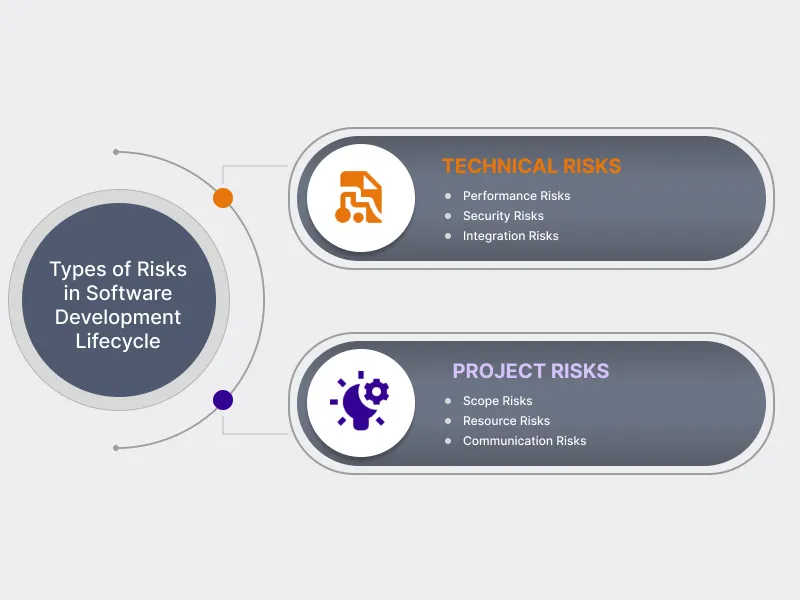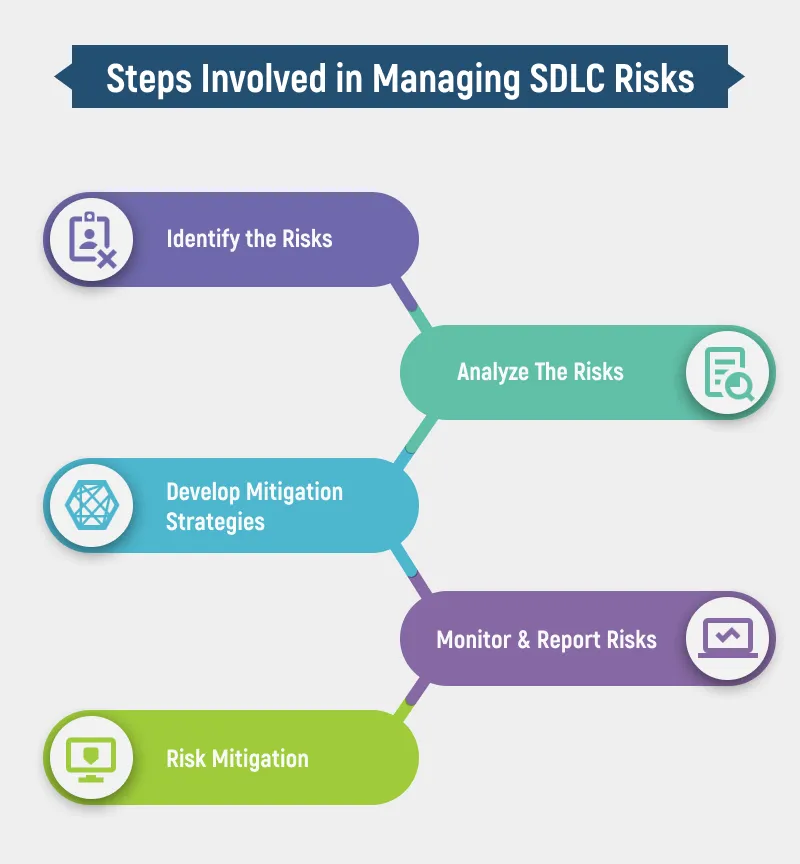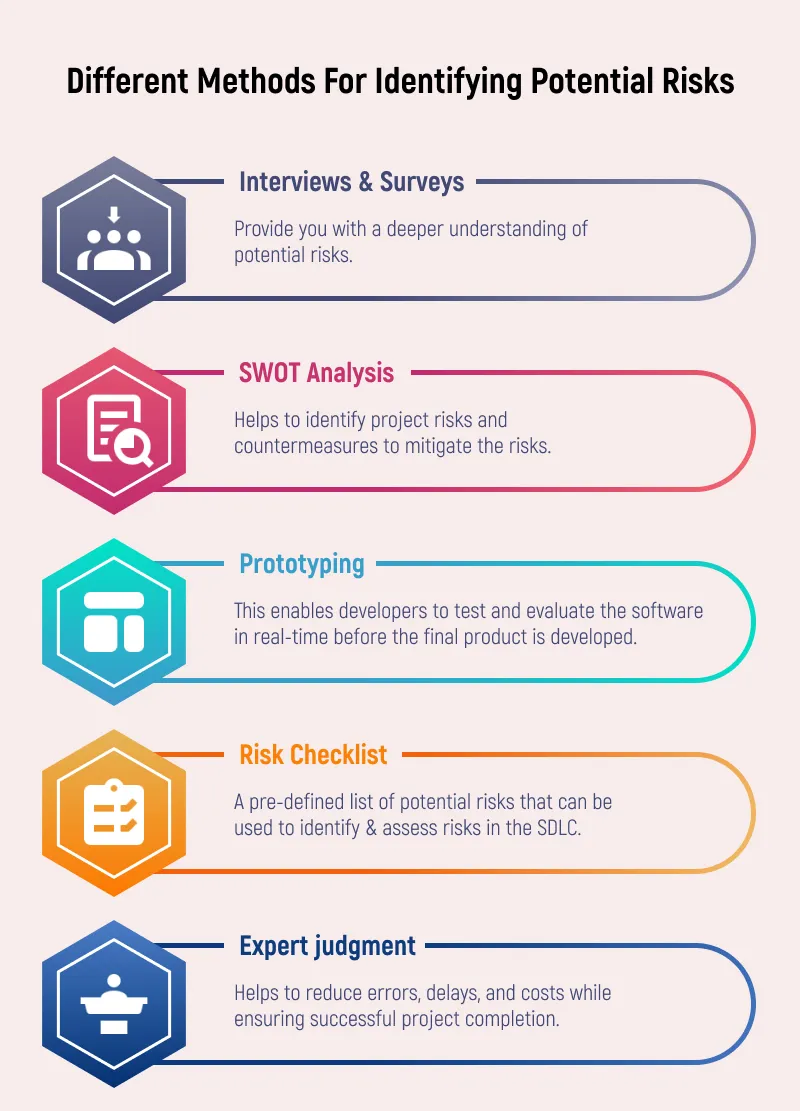A famous saying, “Hope is not a strategy,” perfectly fits risk management in software engineering. It signifies the relevance of proactive planning in software development rather than relying on hope to resolve unforeseen problems.
A survey conducted by Deloitte Insights found that only 61% of respondents considered their institutions to be extremely or very effective at managing cybersecurity risk, while 87% said that improving their ability to manage cybersecurity risk will be an extreme priority over the next two years.
In our previous blog post about the software product lifecycle, we provided detailed information on the development process from start to finish. However, it’s also essential to consider the risks that may be overlooked and could result in significant financial losses after the launch. Implementing effective risk management solutions can be invaluable for tackling these risks and preventing potential disruptions.To help you effectively manage these risks, we have put together some valuable tips and strategies in this blog post.
Importance of Managing Risks in The Software Development Lifecycle
First, let’s understand the importance of risk management in software engineering. Software development is an intricate process involving numerous risks. Businesses must be aware of such risks and prepared to mitigate them. By managing these risks in the software development lifecycle (SDL).
Here are some reasons why software project risk management is essential for software development services companies or software engineers:
- Cost Reduction: Risks in software development can undoubtedly lead to reworks, delays, and project failures, which can prove costly for businesses. With proactive risk analysis at the early stages, project managers can eliminate the extra development cost and finish the project within budget.
- Project Success: Risk analysis in forward engineering is one of the crucial ways to ensure the success of any project by matching the defined timelines, quality, and budget. If project managers can identify and mitigate the risks early, they can ensure positive results for the project.
- Improved Quality: Once the team tackles the risks, the quality of your project will enhance automatically. Because we will already handle one of the biggest challenges, there will be no quality issues.
- Enhanced Customer Satisfaction: Risk management in software engineering can improve software quality and customer satisfaction. Project managers can proactively ensure that the software product meets customer expectations and requirements by managing risks.
- Increased Team Morale: By managing risks proactively, project managers can reduce stress and provide a sense of security for team members. Risks can cause stress & uncertainty for project teams.
We guide your project to success with our risk management expertise.
Types of Risks in Software Development Lifecycle
To manage risk analysis in software engineering, it is essential to be aware of the various risks that can occur throughout the software development lifecycle. Each type of risk requires a distinct approach & strategy. Mainly there are two types of risks:
- Technical Risks
- Project Risks
Technical Risks
- Performance Risks: This type of risk surfaces when the software or system fails to meet performance expectations or requirements. It can lead to slow response times, crashes, or system downtime.
- Security Risks: Security risks are all about vulnerabilities in the software or system that attackers can exploit. It can result in data breaches, system failures, and other security incidents.
- Integration Risks: This risk occurs when integrating new or existing software or systems into development. It can result in compatibility issues or technical challenges that can affect the overall performance and functionality of the software.
Project Risks
This includes software development issues & risks related to technical aspects. Here are some of them:
- Scope Risk: This type of risk arises when there needs to be more clarity or definition around project scope, goals, and objectives. This often leads to scope creep, where the project requirements expand beyond the originally planned, resulting in budget overruns and schedule delays.
- Resource Risk: In this type of risk, there is either lack of availability or a shortage of resources needed for the software development project. This includes issues like insufficient budget, inadequate staffing, or a lack of necessary hardware or software.
- Communication Risk: Lack of communication is also one of the critical risks in software engineering. This type of risk arises when there’s a communication breakdown between project stakeholders, such as developers, managers, & clients. This often causes misunderstandings, delays, and errors in software development.
Also Read: Cybersecurity in Software Development: Why it Matters More Than Ever
Steps Involved in Managing SDLC Risks
Now, let’s look at the essential steps in managing SDLC (Software Development Life Cycle).
1. Identify Risks: The first step of software project risk management is the identification of potential risks. It comprises technical hurdles, budget constraints, lack of resources, and timeline challenges. A comprehensive review of the SDLC process, from project planning to deployment, to identify potential risks may be required at each stage.
2. Analyze Risks: In this stage, the identified risks should be assessed to evaluate their likelihood of occurring and their impact if they occur. It will help prioritize which risks need to be addressed first.
3. Develop Mitigation Strategies: Once you prioritize the risks, it’s time to develop mitigation strategies to alleviate them. These strategies include developing a backup plan, obtaining additional resources, outsourcing work, or adjusting timelines.
4. Monitor & Report Risks: Regular monitoring and reporting of risks should be done throughout the software development process. It will allow for better decision-making and tracking of the success of various mitigation strategies.
5. Risk Mitigation: Regular reviews ensure risks are mitigated on time. If processes are followed correctly, any lessons learned from software project risk management can be applied to future projects. If you lack resources, consider software product development services to ensure the successful implementation of these steps.
Common Risks in Software Development
Software development is a complex process and requires expertise and experience. Let’s look at some of its common risks:
- Scope Creep: It occurs when requirements change midway through the project.
- Poor Quality Control: This risk may arise due to poor quality control and poor maintenance, as software bugs aren’t discovered until after deployment.
- Security Issues: This risk often arises when security issues aren’t appropriately addressed.
- Vendor Reliability: When a vendor fails to deliver on time and creates a reliability gap, it surfaces vendor reliability issues.
- Integration Risks: Integration with other systems or software can be challenging and lead to unexpected problems or issues. It is essential to test integration thoroughly before deployment.
Many companies with experience in software development services can assist you with software project risk management. Their expertise will help you tap into the areas of improvement and access to better resources. ValueCoders has a team of professionals having experience working with clients across the globe. We can help you with the software product development services and mitigate the risks in the SDL.
Optimize your development lifecycle with our efficient project management solutions.
How to Manage Risks in Software Development Lifecycle?
Managing risks in the software development lifecycle involves the following steps:
1. Prioritize Risks
If you want to manage the risks in the software development lifecycle, it is essential to prioritize them based on their potential risks. We should always address the most critical risk first to minimize the adverse effect on the project’s time, budget & quality. This may also involve hiring software product development services through which you can have expertise.
2. Develop Mitigation Strategies
Once you have prioritized the risks, it’s time to develop strategies to mitigate the effects. You can hire offshore software development services or set up a dedicated team to help build effective software project risk management plans. They can outline steps for responding to various scenarios. With this plan in place, software developers are better equipped to handle any challenges during the project.
Here are some different types of mitigation strategies:
- Risk avoidance
- Risk reduction
- Risk transfer
- Risk acceptance
- Risk driver
- Continuous risk assessment
- Monitor Progress
Next is closely monitoring the progress of the software development project. It is essential to monitor the progress regularly to assess how strategies are working and make adjustments if necessary. Monitoring progress also enables teams to identify any new risks that emerge along the way and act quickly to reduce their impact.
3. Document Progress
Thoroughly document all risk assessment and mitigation activities for future reference. Good documentation of progress throughout software engineering projects is essential for successful risk management. By entering progress regularly, teams can review how well strategies have worked and learn from past experiences for future software engineering initiatives.
4. Establish Contingency Plans
It is also essential to establish contingency plans for when they occur. This could include setting aside a budget for additional resources, training team members, or using software outsourcing services for additional support.
Achieve impeccable quality with our thorough testing and QA processes.
Different Methods For Identifying Potential Risks
There are various methods for identifying the potential risks in SDLC that will strengthen your analysis in software engineering. We have listed down some of the most common ones for you below:
Interviews & Surveys
One of the most common methods, interviews and surveys with team members provide a deeper understanding of potential risks as stakeholders can provide insights into possible unforeseen risks. It also includes brainstorming sessions, where everyone shares their opinions and views.
SWOT Analysis
SWOT stands for Strengths, Weaknesses, Opportunities, and Threats. It is one of the best ways to identify and mitigate risks. You can also use risk analysis tools such as FMEA (Failure Mode and Effects Analysis) to help identify potential risks. FMEA aims to identify potential weaknesses in a system that may cause failure and then implement countermeasures to avoid such a situation.
Prototyping
It involves creating a working prototype of the software to identify potential risks related to the user interface, functionality, and other aspects of the software. It enables developers to test and evaluate the software in real-time before the final product is developed. Creating a prototype helps identify potential risks and issues related to the software’s user interface, functionality, and other aspects. It makes necessary changes and improvements before the final product is released.
Risk Checklist
Like other checklists, a risk checklist can help you manage the risks of your software development project. These are pre-defined lists of potential risks that can be used to identify and assess risks in the SDLC. This checklist will ensure that all the potential risks are identified and evaluated.
Expert Judgment
It’s always great to have expert advice to maintain the quality of the project development. Doing so helps to reduce errors, delays, and costs while ensuring successful project completion. The expert review involves seeking input and advice from subject matter experts like developers, testing experts, or project managers to identify the risks and issues.
Also Read: How CRM Software Development can Optimize Performance of Your Business
Importance of Conducting Risk Assessment
Risk assessment is crucial in SDLC as it provides an overview of all the potential risks in software engineering. Here are some key points mentioning the importance of conducting risk assessments:
- Secures software: Conducting risk assessments is essential to ensure the safety of your software development process cycle. Developers can build appropriate security measures to prevent vulnerabilities and protect against cyber attacks by identifying and analyzing potential security risks early in development.
- Enhances software quality: Risk assessment helps to detect potential functional or performance issues that may impact software quality. It enables developers to address these issues early in development and deliver a high-quality product.
- Improves project planning: By identifying potential risks and their impact, risk assessment can help project managers to plan more effectively and allocate resources appropriately.
- Saves time & money: Addressing potential risks early in development can help avoid costly and time-consuming rework.
Risk assessment can provide visibility into areas where additional resources may be needed to reduce the risks associated with software development projects. This can lead to better resource allocation and a higher likelihood of success.
Looking for employee monitoring software for your development team?
Workstatus is the ultimate employee monitoring software for software development companies, providing comprehensive security against risks and threats.
Its advanced monitoring capabilities allow you to track employee activities, selfie validation, and identify potential data breaches. Safeguard your company’s sensitive data, ensure compliance, and proactively mitigate risks with Workstatus.
Take control of your software development environment and protect your company from potential threats.
Conclusion
Managing the risks of the software development lifecycle is integral, it helps the companies avoid challenges post-launch. By proactively assessing and addressing potential dangers during each stage of the SDLC, organizations can ensure their projects are completed on time, within budget, and with minimal disruption.
The above strategies will help you efficiently tackle the risks and ensure the success of your project. An effective risk management strategy can help ensure successful project completion, reduce the impact of unanticipated issues, and lead to better cost savings and customer satisfaction.








